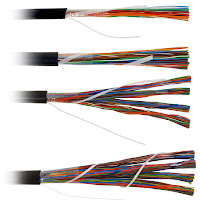4.1 Unshielded Twisted Pair (UTP) Cable
Twisted pair cabling
comes in two varieties: shielded and unshielded. Unshielded twisted pair (UTP)
is the most popular and is generally the best option for school networks.
 |
| Unshielded twisted pair |
The quality of UTP may
vary from telephone-grade wire to extremely high-speed cable. The cable has
four pairs of wires inside the jacket. Each pair is twisted with a different
number of twists per inch to help eliminate interference from adjacent pairs
and other electrical devices. The tighter the twisting, the higher the
supported transmission rate and the greater the cost per foot. The EIA/TIA
(Electronic Industry Association/Telecommunication Industry Association) has
established standards of UTP and rated six categories of wire (additional
categories are emerging).
Categories of Unshielded Twisted Pair
Category
|
Speed
|
Use
|
1
|
1 Mbps
|
Voice Only (Telephone Wire)
|
2
|
4 Mbps
|
LocalTalk & Telephone (Rarely
used)
|
3
|
16 Mbps
|
10BaseT Ethernet
|
4
|
20 Mbps
|
Token Ring (Rarely used)
|
5
|
100 Mbps (2 pair)
|
100BaseT Ethernet
|
1000 Mbps (4 pair)
|
Gigabit Ethernet
|
|
5e
|
1,000 Mbps
|
Gigabit Ethernet
|
6
|
10,000 Mbps
|
Gigabit Ethernet
|
Unshielded Twisted Pair Connector
The standard connector
for unshielded twisted pair cabling is an RJ-45 connector. This is a plastic
connector that looks like a large telephone-style connector. A
slot allows the RJ-45 to be inserted only one way. RJ stands for Registered
Jack, implying that the connector follows a standard borrowed from the
telephone industry. This standard designates which wire goes with each pin
inside the connector.

No comments:
Post a Comment